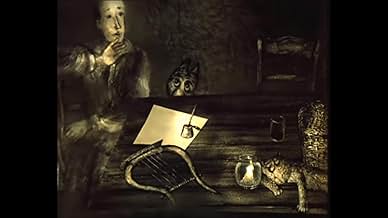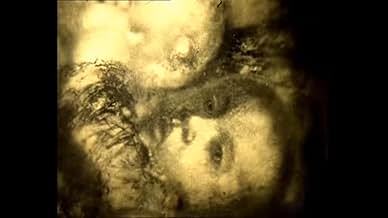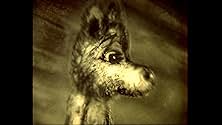Skazka skazok
- 1979
- 29 Min.
IMDb-BEWERTUNG
7,8/10
4374
IHRE BEWERTUNG
Füge eine Handlung in deiner Sprache hinzuDistant, well-worn memories of childhood are inhabited by a little gray wolf. Through astonishing imagery, the memory of all of Russia is depicted.Distant, well-worn memories of childhood are inhabited by a little gray wolf. Through astonishing imagery, the memory of all of Russia is depicted.Distant, well-worn memories of childhood are inhabited by a little gray wolf. Through astonishing imagery, the memory of all of Russia is depicted.
- Regie
- Drehbuch
- Hauptbesetzung
- Auszeichnungen
- 2 wins total
Aleksandr Kalyagin
- Little Grey Wolf
- (Synchronisation)
Empfohlene Bewertungen
I love "Triplets of Bellville" and I admire "Spirited Away" but "Skazka skazok (Tale of Tales)" (1979) is the pinnacle of the Medium for me. What Norstein had achieved in his 30 minutes long animated film that was made over 30 years ago is akin to what Andrei Tarkovski did in in his Zerkalo (Mirror) - captured time and memory of one child and the whole generation and projected them in the images and sounds that stay with you forever.
His incredible images accompanied by the music of Mozart, Bach, and the famous tango "The Wayworn Sun" - the same one Nikita Mikhalkov used in his film "Burnt by the Sun" - bring to life forever gone but always alive in one's heart happiness, innocence, and memory of the childhood that are indelible from the history of the country and the Artist's search for beauty and meaning.
The images or the war are absolutely heartbreaking. There are no combats on the screen but the scenes with the dancing couples, the men going to the war, and the notifications of death ("pochoronki") flying like birds of death to waiting in hope women: mothers, wives, and sisters are unforgettable.
Norstein is known for being a perfectionist - his resume includes only six films - combined, they last less than 80 minutes. Each of the minutes is perfection itself. Norstein puts a piece of his heart in every single frame of his small gems. He is the Artist and the Humanist - one of the best directors ever, and not only in Animation.
His incredible images accompanied by the music of Mozart, Bach, and the famous tango "The Wayworn Sun" - the same one Nikita Mikhalkov used in his film "Burnt by the Sun" - bring to life forever gone but always alive in one's heart happiness, innocence, and memory of the childhood that are indelible from the history of the country and the Artist's search for beauty and meaning.
The images or the war are absolutely heartbreaking. There are no combats on the screen but the scenes with the dancing couples, the men going to the war, and the notifications of death ("pochoronki") flying like birds of death to waiting in hope women: mothers, wives, and sisters are unforgettable.
Norstein is known for being a perfectionist - his resume includes only six films - combined, they last less than 80 minutes. Each of the minutes is perfection itself. Norstein puts a piece of his heart in every single frame of his small gems. He is the Artist and the Humanist - one of the best directors ever, and not only in Animation.
This would be the ultimate 3D film experience. I wanted to see this again as preparation for Tarkovsky's "Nostalghia" (1983), which I've long regarded as one of the most amazing films ever made. This, I think, exhibits the same kind of existential meta-melancholy that's somehow deeply rooted in the fabric of the creative process depicted by many of the Russian artists; then, as noted, this has an amazingly perceptive visual eye making it more than a fitting prelude.
It's like entering an infant's dream. Everything is new, nothing is named. What we see is emotion. Color as emotion, motion as emotion, character as emotion. The layered images are stunning, and the eye moves restlessly, zooming in and out on objects and is at times perplexingly active as if it didn't know where it was going, and at times hesitantly passive.
Dreams of a dreamed up being, the maroon light swallowing the thin silhouette-like figures. The minotaur-like figure jumping rope. The wolf, alone in the forest at the fire, taken in by the mysterious light (a sure influence on Polanski and his The Ninth Gate [1999]). This must've been a great influence on Chomet, as well.
This is on par with and in my estimation exceeds "L'Homme qui plantait as arbres" (1988), and a very worthy companion for the best of the Quay Brothers as short animation that reshapes how we see and think, and most importantly, how we dream.
It's like entering an infant's dream. Everything is new, nothing is named. What we see is emotion. Color as emotion, motion as emotion, character as emotion. The layered images are stunning, and the eye moves restlessly, zooming in and out on objects and is at times perplexingly active as if it didn't know where it was going, and at times hesitantly passive.
Dreams of a dreamed up being, the maroon light swallowing the thin silhouette-like figures. The minotaur-like figure jumping rope. The wolf, alone in the forest at the fire, taken in by the mysterious light (a sure influence on Polanski and his The Ninth Gate [1999]). This must've been a great influence on Chomet, as well.
This is on par with and in my estimation exceeds "L'Homme qui plantait as arbres" (1988), and a very worthy companion for the best of the Quay Brothers as short animation that reshapes how we see and think, and most importantly, how we dream.
I admit I didn't really "get" this film. There are probably references to things in Russian history and culture that go over my head. But I admire the effort, style and vision that went into this dreamlike fantasy about childhood and war (I think).
10kamerad
I must discuss the Russian Yuri Norstein's stunning "Tale of Tales". Like the films of another great Russian filmmaker, Andrei Tarkovsky, this film is about memory and nostalgia. The uses of various techniques of animation, primarily cutouts, not only let us see Norstein's memories, but also help illustrate their dream-like qualities. There are events in this film that, taken literally, could not have happened. However Norstein represents these memories metaphorically, thereby making their emotional impact greater than were he to simply illustrate his memories in a straight forward narrative.
There are a couple of moments that reflect the above-mentioned statement that I feel I must include in this entry. I loved the scene where the little boy is standing in the snow eating an apple , looking up at some crows on a tree branch. The boy then appears on the branch, buddies up with the crows and shares his apple with them. This is a great, moving, but non-sentimental image that lets us feel the child's desire for friendship. Just after that, his father, whose Napoleon hat identifies him as a tyrant, yanks him out of his daydream. The little boy at first struggles, but then a little Napoleon hat appears on his head and he marches in file behind his dad. This scene reminded me of the Disney WWII era short "Education for Death", in that it also is about childhood innocence being destroyed by adults conditioning their behavior. But where "Education." was a didactic propaganda tool, "Tale of Tales" simply shows how sad and unfortunate it is for adults to do that to children, and illustrates it in such a poetic way.
There are a couple of moments that reflect the above-mentioned statement that I feel I must include in this entry. I loved the scene where the little boy is standing in the snow eating an apple , looking up at some crows on a tree branch. The boy then appears on the branch, buddies up with the crows and shares his apple with them. This is a great, moving, but non-sentimental image that lets us feel the child's desire for friendship. Just after that, his father, whose Napoleon hat identifies him as a tyrant, yanks him out of his daydream. The little boy at first struggles, but then a little Napoleon hat appears on his head and he marches in file behind his dad. This scene reminded me of the Disney WWII era short "Education for Death", in that it also is about childhood innocence being destroyed by adults conditioning their behavior. But where "Education." was a didactic propaganda tool, "Tale of Tales" simply shows how sad and unfortunate it is for adults to do that to children, and illustrates it in such a poetic way.
Grand Prize winner at the Zagreb World Festival of Animated Films Russian director Yuri Norstein's Tale of Tales (alternately titled The Little Grey Wolf Will Come) was named by the 1984 Animation Olympiad jury at the L.A. Olympics as the greatest animated film of all time. Written by Ludmilla Petrushevskaya and Norstein, like Tarkovsky's Zerkalo (The Mirror), it consists of fleeting images, snippets of memory from the director's life. According to Norstein, the film was inspired by the poem Tale of Tales by Nazim Hikmet:
"We stand above the water - sun, cat, plane tree, me and our destiny. The water is cool, The plane tree is tall, The sun is shining, The cat is dozing, I write verses. Thank God, we live!"
The film opens with a grey wolf singing a Russian lullaby to a baby in a cradle:
"Baby baby rock-a-bye On the edge you mustn't lie Or the little grey wolf will come And will nip you on the tum Tug you off into the wood Underneath the willow-root."
Backed by an original score by Mikhail Meerovich and the music of Bach and Mozart, images roll by, some repeated during the film, without any apparent connection: a sad eyed grey wolf nurturing a little baby, a boy eating a green apple, then feeding it to the crows, a passive bull skipping rope with a small girl, men and women's dancing interrupted by soldiers, a woman sitting on a bench with her drunk husband, a man and his son wearing Napoleon hats ostensibly going off to war, women mourning the death of loved ones in the war, apples falling in the snow, among others. Norstein describes the film as being "about simple concepts that give you the strength to live."
Claire Kitson, former Commissioning Editor of Animation for the UK's Channel 4, in her book about the film: Yuri Norstein and Tale of Tales – An Animator's Journey by Clare Kitson. London, U.K., & Bloomington, IN: John Libbey & Indiana University Press, 2005), says that the images are not metaphors but actual events in the director's life. For instance, the woman sitting in a bench with a drunk husband comes from a couple casually spotted by co-writer Lyudmila Petrushevskaya, the apple from a happy and tasty experience of Norstein eating an apple while walking in the street during the winter, and the old house from the actual house that he dwelled in during his childhood.
But she warns that "the film is about memory and ...is also constructed like a memory" and adds: "this is achieved by the construction of a set of parallel worlds: the old house with, nearby, an old streetlight and the setting for wartime scenes; the poet's world, where a fisherman's family also lives and a bull and a walker come to visit; the snowbound winter world of the boy and the crows; and the forest next to a highway, where the Little Wolf makes his home under the brittle willow bush. In short, we must appreciate bull, poet, wolf, house, snow and so on not like metaphors of something else, but like bricks in a palace, notes in a symphony."
Selecting it as one of the fifteen greatest "seeking" films of all time, directors Gregory and Maria Pears described it on their website www.cinemaseekers.com as follows: "Through its philosophical depths, its visionary language and its use of sound and music, it raises animation to the level of the very best art cinema. Norstein is a consummate artist, who insists on painting every frame himself. The result is the totally unique evocation of his spiritual world that could only have been rendered through animation - no other cinematic form would have sufficed."
Enigmatic, magically beautiful, and very moving, Tale of Tales is a work of art that you cannot figure out but can only experience just by letting it roll over you like a warm breeze.
The 27-minute film is available on You Tube with English subtitles.
http://www.youtube.com/watch?v=b_q3WoYawNI
"We stand above the water - sun, cat, plane tree, me and our destiny. The water is cool, The plane tree is tall, The sun is shining, The cat is dozing, I write verses. Thank God, we live!"
The film opens with a grey wolf singing a Russian lullaby to a baby in a cradle:
"Baby baby rock-a-bye On the edge you mustn't lie Or the little grey wolf will come And will nip you on the tum Tug you off into the wood Underneath the willow-root."
Backed by an original score by Mikhail Meerovich and the music of Bach and Mozart, images roll by, some repeated during the film, without any apparent connection: a sad eyed grey wolf nurturing a little baby, a boy eating a green apple, then feeding it to the crows, a passive bull skipping rope with a small girl, men and women's dancing interrupted by soldiers, a woman sitting on a bench with her drunk husband, a man and his son wearing Napoleon hats ostensibly going off to war, women mourning the death of loved ones in the war, apples falling in the snow, among others. Norstein describes the film as being "about simple concepts that give you the strength to live."
Claire Kitson, former Commissioning Editor of Animation for the UK's Channel 4, in her book about the film: Yuri Norstein and Tale of Tales – An Animator's Journey by Clare Kitson. London, U.K., & Bloomington, IN: John Libbey & Indiana University Press, 2005), says that the images are not metaphors but actual events in the director's life. For instance, the woman sitting in a bench with a drunk husband comes from a couple casually spotted by co-writer Lyudmila Petrushevskaya, the apple from a happy and tasty experience of Norstein eating an apple while walking in the street during the winter, and the old house from the actual house that he dwelled in during his childhood.
But she warns that "the film is about memory and ...is also constructed like a memory" and adds: "this is achieved by the construction of a set of parallel worlds: the old house with, nearby, an old streetlight and the setting for wartime scenes; the poet's world, where a fisherman's family also lives and a bull and a walker come to visit; the snowbound winter world of the boy and the crows; and the forest next to a highway, where the Little Wolf makes his home under the brittle willow bush. In short, we must appreciate bull, poet, wolf, house, snow and so on not like metaphors of something else, but like bricks in a palace, notes in a symphony."
Selecting it as one of the fifteen greatest "seeking" films of all time, directors Gregory and Maria Pears described it on their website www.cinemaseekers.com as follows: "Through its philosophical depths, its visionary language and its use of sound and music, it raises animation to the level of the very best art cinema. Norstein is a consummate artist, who insists on painting every frame himself. The result is the totally unique evocation of his spiritual world that could only have been rendered through animation - no other cinematic form would have sufficed."
Enigmatic, magically beautiful, and very moving, Tale of Tales is a work of art that you cannot figure out but can only experience just by letting it roll over you like a warm breeze.
The 27-minute film is available on You Tube with English subtitles.
http://www.youtube.com/watch?v=b_q3WoYawNI
Wusstest du schon
- WissenswertesThe sound of the baby drinking his milk was actually the sound of a puppy, and the sad eyes of the wolf were copied from a magazine picture of a rescued kitten.
- VerbindungenFeatured in Animated Century (2003)
- SoundtracksUtomlyonnoe solntse
Written by Jerzy Petersburski
Russian lyrics by Iosif Alvek
Performed by Aleksandr Tsfasman
Top-Auswahl
Melde dich zum Bewerten an und greife auf die Watchlist für personalisierte Empfehlungen zu.
Details
Box Office
- Weltweiter Bruttoertrag
- 82.099 $
Zu dieser Seite beitragen
Bearbeitung vorschlagen oder fehlenden Inhalt hinzufügen
















